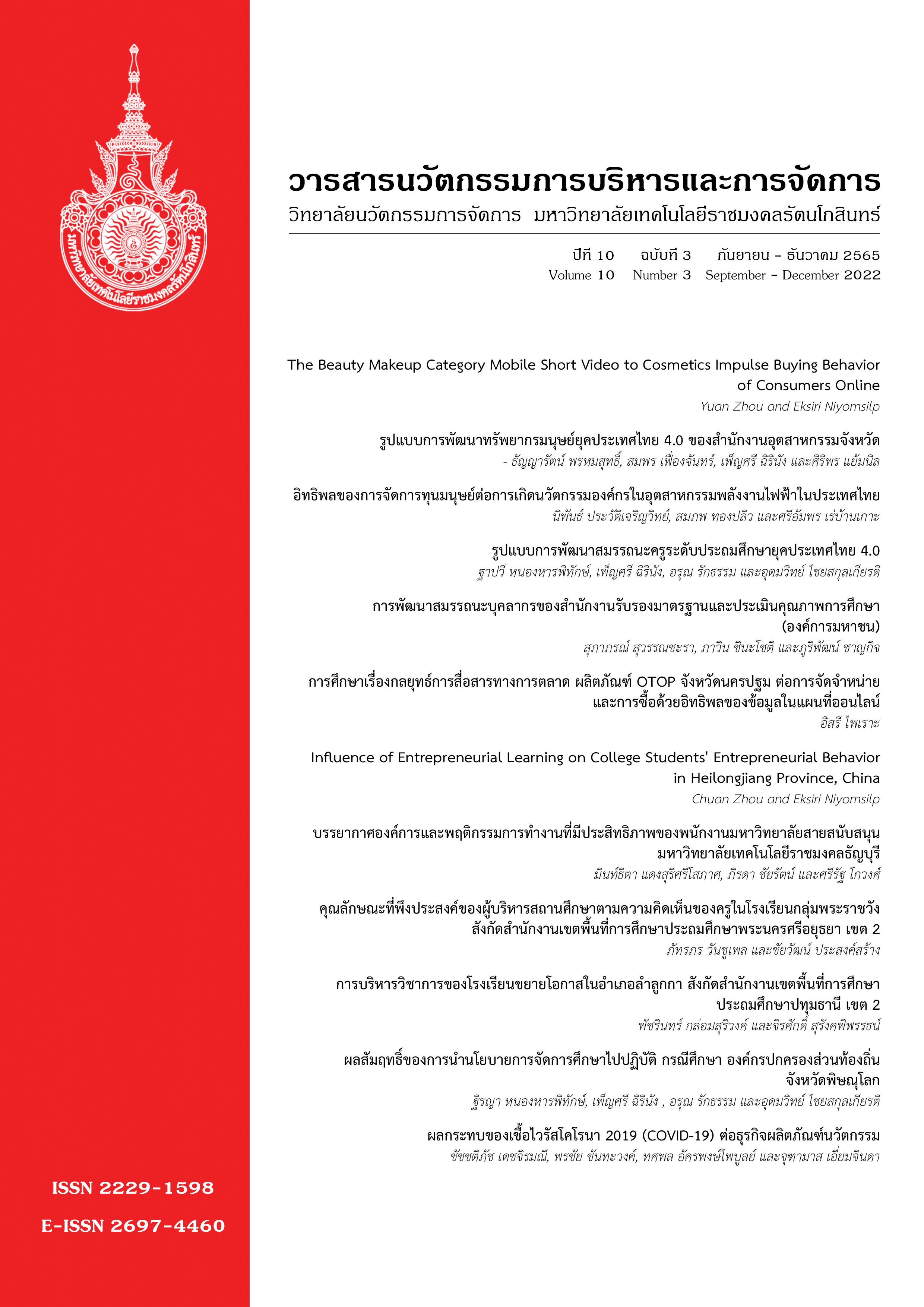อิทธิพลของการจัดการทุนมนุษย์ต่อการเกิดนวัตกรรมองค์กร ในอุตสาหกรรมพลังงานไฟฟ้าในประเทศไทย
Main Article Content
บทคัดย่อ
งานวิจัยนี้มีวัตถุประสงค์เพื่อศึกษาถึงความสัมพันธ์ของการจัดการทุนมนุษย์ในองค์กรรวมถึงอิทธิพลของการจัดการทุนมนุษย์ที่มีต่อการเกิดนวัตกรรมในองค์กร โดยศึกษาในองค์กรที่เกี่ยวข้องกับอุตสาหกรรมพลังงานไฟฟ้าในประเทศไทย โดยมีประชากรคือบุคลากรที่ทำงานในอุตสาหกรรมพลังงานไฟฟ้าในประเทศไทย และทำการเก็บข้อมูลจากกลุ่มตัวอย่าง 400 คน ใช้แบบสอบถามเป็นเครื่องมือในการวิจัยและทำการวิเคราะห์ข้อมูลเชิงสถิติด้วยวิธีการวิเคราะห์สมการเชิงโครงสร้าง จากการวิเคราะห์ข้อมูลพบว่า ค่าสถิติพื้นฐานในการคำนวณผ่านเกณฑ์มาตรฐานทุกค่า คือ x2 / df = 1.539, GFI = .985, AGFI = .969, NFI = .992, IFI = .997, CFI = .997, RMR = .007, SRMR = .0148, RMSEA = .036, PCLOSE (p-value for test of close fit) = .800 และ CN = 488.000โดยสรุปได้ว่า การจัดการทุนมนุษย์มีอิทธิพลโดยตรงต่อการเกิดนวัตกรรมในองค์กร โดยปัจจัยที่ส่งผลต่อการจัดการทุนมนุษย์มากที่สุด คือ การพัฒนาทุนมนุษย์ที่อยู่ในองค์กร และปัจจัยที่ส่งผลต่อการเกิดนวัตกรรมในองค์กรมากที่สุด คือ ศักยภาพทางเทคโนโลยีและศักยภาพขององค์กร
Article Details

อนุญาตภายใต้เงื่อนไข Creative Commons Attribution-NonCommercial-NoDerivatives 4.0 International License.
ข้อความและบทความในวารสารนวัตกรรมการบริหารและการจัดการ เป็นแนวคิดของผู้เขียน ไม่ใช่ความคิดเห็นและความรับผิดชอบของคณะผู้จัดทำ บรรณาธิการ กองบรรณาธิการ วิทยาลัยนวัตกรรมการจัดการ และมหาวิทยาลัยเทคโนโลยีราชมงคลรัตนโกสินทร์
ข้อความ ข้อมูล เนื้อหา รูปภาพ ฯลฯ ที่ได้รับการีพิมพ์ในวารสารนวัตกรรมการบริหารและการจัดการ ถือเป็นลิขสิทธิ์ของวารสารนวัตกรรมการบริหารและการจัดการ หากบุคคลใดหรือหน่วยงานใดต้องการนำทั้งหมดหรือส่วนหนึ่งส่วนใดไปเผยแพร่ต่อหรือกระทำการใดๆ จะต้องได้รับอนุญาติเป็นลายลักษณ์อักษรจากวารสารนวัตกรรมการบริหารและการจัดการก่อนเท่านั้น
เอกสารอ้างอิง
กันยารัตน์ จันทร์สว่าง และ สุภาวดี พรหมบุตร. (2019). ทุนมนุษย์กับการเปลี่ยนแปลง: กระบวนทัศน์ใหม่ของการบริหาร
ทรัพยากรมนุษย์. วารสารวิทยาการจัดการ มหาวิทยาลัยราชภัฏสุราษฎร์ธานี, 6(2), 209-222.
กัลย์ ปิ่นเกษร, เฉลิมชัย กิตติศักดิ์นาวิน และ จิราวรรณ คงคล้าย. (2017). ทุนมนุษย์: ตัวชี้วัดทุนมนุษย์ระดับองค์การ.
วารสารบัณฑิตศึกษา มหาวิทยาลัยราชภัฏวไลยอลงกรณ์ ในพระบรมราชูปถัมภ์, 11(2), 193-202.
กรมพัฒนาธุริกิจการค้า. (2563). บทวิเคราะห์ธุรกิจ Business Analysis Report.
จาก https://www.dbd.go.th/download/document_file/Statisic/2563/T26/T26_202006.pdf.
วัชรพจน์ ทรัพย์สงวนบุญ และ ปรียากมล เอื้องอ้าย. (2020). การพัฒนานวัตกรรมของอุตสาหกรรมการผลิต
เพื่อสร้างความสามารถทางการแข่งขันองค์กร. วารสารนวัตกรรมการบริหารและการจัดการ, 8(2), 89-100.
Cahyaningsih, E., Sensuse, D. I., Arymurthy, A. M., and Wibowo, W. C. (2017). Nusantara: a new model of
knowledge management in government human capital management.
Procedia Computer Science, 124, 61-68.
Donate, M. J., Peña, I., & Sanchez de Pablo, J. D. (2016). HRM practices for human and social capital
development: effects on innovation capabilities. The International Journal of Human Resource
Management, 27(9), 928-953.
Harrison, P., & Ludwig, J. (2004). The Impact of US Firms’ Investments in Human Capital on Stock Prices.
from https://atdsfeastbay.org/Resources/Documents/Meetings/2010-07%20Gina%20Jesse%20
Impact%20on%20Stock%202004%20research-Bassi.pdf
Kline, R. B. (2015). Principles and practice of structural equation modeling. Guilford publications.
McKeown, N., Anderson, T., Balakrishnan, H., Parulkar, G., Peterson, L., Rexford, J., ... & Turner, J. (2008).
OpenFlow: enabling innovation in campus networks. ACM SIGCOMM computer communication review,
(2), 69-74.
Rajapathirana, R. J., & Hui, Y. (2018). Relationship between innovation capability, innovation type,
and firm performance. Journal of Innovation & Knowledge, 3(1), 44-55.


